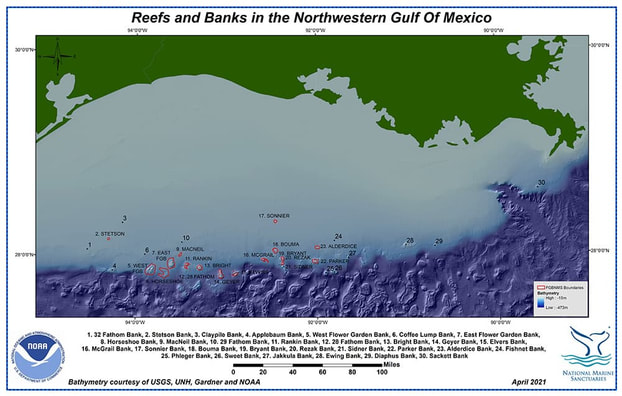Exploration, Habitat Characterization, and Coral Reef Ecology in Flower Garden Banks National Marine Sanctuary and the NW Gulf of Mexico
|
The Flower Garden Banks National Marine Sanctuary (FGBNMS) is comprised of stunning and unique shelf-edge coral reef habitats in the northwest Gulf of Mexico (GOM). Our collaborative research approach in this region combines habitat characterization, population genetics, biophysical modeling, and molecular ecology to understand ecosystem functions and enhance management strategies. Complementary methods include SCUBA, technical diving, fish acoustics sonar, and remotely operated vehicles (ROVs) to survey benthic and fish communities, collect biological samples, and deploy oceanographic equipment.
|
|
This project builds into our larger Mesophotic Coral Reef initiative and deep coral exploration through the Cooperative Institute for Ocean Exploration, Research, and Technology (CIOERT). Our outreach efforts related to this research include public presentations, project videos, still images, and participation in telepresence-enabled ROV cruises at FGBNMS bringing the excitement of mesophotic exploration in the northwest GOM to streaming devices worldwide.
Assessment of Connectivity through Population Genetics and Biophysical Modeling
 Map Credit: Sanctuary Advisory Council, FGBNMS Expansion Preferred Alternative 3
Map Credit: Sanctuary Advisory Council, FGBNMS Expansion Preferred Alternative 3
At the start of this project, three out of the dozens of banks along the continental shelf margin were protected within Flower Garden Banks National Marine Sanctuary (West FGB, East FGB, and Stetson Bank). Some of the other mesophotic banks to the east of FGBNMS were protected from fishing and offshore oil activities (Bright, Geyer, and McGrail Banks) as Coral Habitat Areas of Particular Concern (CHAPCs).
Recent efforts to expand the boundaries of the sanctuary succeeded in bringing the total of protected banks to 17, many of which include critical mesophotic reef habitat. Using SNPs, and previously microsatellite markers, from the dominant coral species Montastraea cavernosa, we determined how coral populations across the GOM interact with populations in FGBNMS and nearby mesophotic banks. In combination with a biophysical model estimating larval migration within the northwest GOM, we've identified that some of the banks in the new sanctuary expansion area likely contribute to the FGBNMS East and West Bank populations. We have expanded our connectivity analyses across the northwest GOM to additional species including corals, sponges, and fish using single nucleotide polymorphism (SNP) population genetics markers.
Recent efforts to expand the boundaries of the sanctuary succeeded in bringing the total of protected banks to 17, many of which include critical mesophotic reef habitat. Using SNPs, and previously microsatellite markers, from the dominant coral species Montastraea cavernosa, we determined how coral populations across the GOM interact with populations in FGBNMS and nearby mesophotic banks. In combination with a biophysical model estimating larval migration within the northwest GOM, we've identified that some of the banks in the new sanctuary expansion area likely contribute to the FGBNMS East and West Bank populations. We have expanded our connectivity analyses across the northwest GOM to additional species including corals, sponges, and fish using single nucleotide polymorphism (SNP) population genetics markers.
Investigation of Mesophotic Coral Physiology with Morphometrics, Algal Symbiosis, and Gene Expression
How do shallow and mesophotic corals adapt to their different environments? Light limitation at mesophotic depths results in morphological, physiological, and symbiotic shifts and may influence population dynamics across depth ranges and broad spatial scales. Mesophotic corals in the NW GOM demonstrate photoadaptive strategies relative to their shallow counterparts, including smaller skeletal structures and increased symbiont densities.
More detailed assessment of corals' responses to changing environments can be accomplished through differential gene expression studies. Using a tag-based RNA-Seq pipeline, we have sequenced Montastraea cavernosa transcriptomes from sites throughout the GOM, including Belize, Flower Garden Banks, Pulley Ridge, and Dry Tortugas. Additionally, our transplant experiments at West and East Flower Garden Banks where colonies were moved from mesophotic to shallow depth zones have identified lower bleaching thresholds in mesophotic corals and a "core set" of genes whose differential expression may influence photoadaptation at depth.
More detailed assessment of corals' responses to changing environments can be accomplished through differential gene expression studies. Using a tag-based RNA-Seq pipeline, we have sequenced Montastraea cavernosa transcriptomes from sites throughout the GOM, including Belize, Flower Garden Banks, Pulley Ridge, and Dry Tortugas. Additionally, our transplant experiments at West and East Flower Garden Banks where colonies were moved from mesophotic to shallow depth zones have identified lower bleaching thresholds in mesophotic corals and a "core set" of genes whose differential expression may influence photoadaptation at depth.
